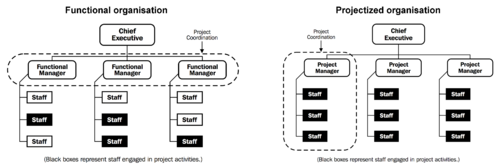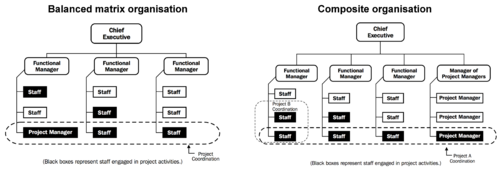Context element
| Line 22: | Line 22: | ||
The project context can also describe the type of project. In general four different types of projects can be identified as | The project context can also describe the type of project. In general four different types of projects can be identified as | ||
| − | + | # Engineering projects | |
| − | + | # New product development | |
| − | + | # Systems development | |
| − | + | # Organisational change pojects | |
Revision as of 09:01, 27 February 2019
Contents |
WORK IN PROGRESS
To the reviewer: I only found time to finish the Background section, so disregard the other parts.
Abstract
The topic of this article is the context element of project management. The context element is a concept in project management, that provides an understanding of how outside factors and environment impact a certain project. The environment in which a project is determines many the limitations, requirements and possibilities of the project. This article will provide a theoretical understanding of the context element and describe different contexts. Furthermore the article will present the relevant models that can be used to understand and manage the context element, and lastly it will present the limitations of the context element and the related models.
- Abstract bør opsummere alt hvad der er skrevet i artiklen, gen-skriv til slut*
Background
The context element is a concept in project management that is related to the environment around a project and how it influences it. The context of a project sets limitations and can create challenges. It is important to take the context into account, so the project can be planned and adjusted accordingly to the limitations sets by factors outside the project. The context element is a wide concept and covers a wide range of different factors of different importance that influence the limitations, the resources and many other aspects. In order to get a better overview of the concept, it can be organised into the different categories, the project context, the temporal context, the organisational context and the external context [1].
The project context
The project context covers the elements designed for projects within an organisation, but not the project specifically. This includes project governance and steering committees, the Project Management office, program and portfolio management. Many organisations have specific policies and procedures for projects. Projects also exist in organisational cultures consisting of the shared values, norms and expectations. In companies that are more innovative and entrepreneurial, high risk proposals are more likely to be accepted, and vice versa for conservative organisational cultures. Another example is the view of hierarchical structures within an organisation. In the Nordic countries there is a tendency towards a flat hierarchy, which means a project management style of top-down leadership might cause conflicts [1],[2].
The project context can also describe the type of project. In general four different types of projects can be identified as
- Engineering projects
- New product development
- Systems development
- Organisational change pojects
- i need to find more about this*
The ISO 21500 gives a visual representation of the project context as shown in Figure 3.
Maybe something about life cycles? [2 p12]
The temporal context
Any project exists in the context of the past projects from which experience can be utilised and future projects that can utilize lessons from the current project. The lessons from past projects weaknesses and strengths of certain processes, procedures, techniques and tools [3]. How to best utilize past experience and capture lessons from a current project is described in the Application section.
Organisational context
All projects, except rare cases, exists within a organisational environment and a corporate context. Classically organisations that undertake projects can be described as being functional or projectized organisations. It should be noted that the classification is a spectrum and many organisations lie somewhere between the to classifications.
Functional organisations
In traditional functional organisations the staff is organised by their type of work and their are clear reporting lines to the respective management of each work function. When projects are undertaken in functional they are often separated into phases corresponding to the responsibilities of the functional groups. For example in product development, the first phase is often the design phase and will be undertaken as a individual project by the design/engineering department. Subsequently the manufacturing department undertakes the next phase as an individual project. This means that questions and challenges related to their other phases of the project often are communicated to the department head, who consults the associated department head who then contacts the relevant staffing. This process is cumbersome and delay decision making which can lead to delay of the projects [4]. Another issue that project managers in functional organisations should be aware of is if functional managers are rewarded for assigning staff time to projects. In these cases it is important for the project manager to control that assigned staff is being used effectively [2].
When cross-functional projects are undertaken in functional organisations some challenges might arise for the project manager if the overall leadership is not clearly defined. One solution is to define clear project controls at the start of the project, and agreeing these with the project board. This will help to "ensure that the project manager understands the level of interaction and support to expect during the project and is given appropriate exposure to other areas of the corporate organization" [3].
Projectized organisations
Project based organisations are typically companies that derive their primary revenue from projects (engineering firms, government contractors, consultants etc.). In projectized organisations the project members are typically co-located regardless of their functional group and reporting is typically done directly to the project manager. For projects undertaken in these organisations, the project management often have a greater deal of independence and authority over the allocated project staff. These organisations often have systems in place that support the project management such as financial systems for accounting and reporting of projects [2].
Matrix and composite organisations
Organisations that are both functional and projectized are called matrix organisations. The matrix organisation evolved during the late 1960 in order to push decision making to a lower level without loosing the inputs of all affected units [4]. In weak matrix organisations the role of the project manager resembles more that of a coordinator, while the strong matrix organisation resembles the projectized organisation where the project management have more authority while the organisation still maintain the traditional functional departments. The balanced matrix organisation, shown in Figure 2 (left) is somewhere in between. Most modern organizations are composite organisations, that have a mix of all these traits at various levels in the organisation. Even highly functional organisations will create special project teams to handle crucial projects.
External context
The external context consist of institutions and factors outside the control of the organisation hosting the project. Even though these factors are outside the control of the project management it is crucial to be aware of the external context.
Standards and regulation
Standards are collections of rules, guidelines and practices published by a recognized body. Compliance with standards are typically not mandatory but only recommended. Standards are important because they facilitate business interactions, enable compliance with regulations, provide interoperability between new and existing products, etc [5].
Regulations are mandatory, with compliance regulated at different levels either governmental or organisational. In a danish context the Eurocodes in construction are an example of a collection of standards that are also regulations, as compliance is mandatory by danish law [2].
Internationalization and cultural influence
In the modern world more and more projects consists of contributions across borders. In international projects it is important to be aware of the impacts of time-zones, national and religious holidays, travel requirements and so on. Likely it is important to be aware of the cultural context that a project operate within. The cultural context impacts the way that people and organisations interact [2].
Social-Economic-Environmental sustainability Essentially any project undertaken has an social, economic or environmental impact, both intended and unintended. As more and more organisations are held responsible for these impacts, it is important for project managers to have at least some awareness of the social, economic and environmental context that it is a part of [2].
Application and Tools
The context element is a concept, and can therefore not be applied in itself, but in the scientific literature there exist a range of models and tools that can help understand, manage and (..) the contextual element of a project. In Prince2 ...
Utilizing the temporal context
The temporal context can be utilized in project management by using past lessons and capturing lessons for future project. Describe the guidelines from Section 14.4.2 in PRINCE2. Find some guidelines for how to capture lessons (maybe in PRINCE2 or ISO).
How to utilise the org context
How should a project manager use the context element.
-Triple constraint model
- Matrix - Co-location of teams (Project-half double) - The four levels of management recomended by Prince2 - Stakeholder management
- Utilising past experience
Stakeholder management
Both external and internal stakeholder managementStakeholder Management.
Limitations
It's difficult to talk about limitations of the context element as it is a concept, that holds for every project. Every project exists in a specific context, of both the organisation it's in, the context of previous experiences and so. However the concept is sometimes considered as vague. [source].
Limitations of the temporal context
As described in the Application section, the experiences gained from previous projects can be used on new projects. However, a key characteristics of projects is that they are unique [1]. This means that there will always be limitations when using experiences between projects. (more)
Annotated bibliography (3-5)
1. Prince2 about projcts in commercial environment. As mentioned, projects in commercial environments for example joint venture and collaborative research can be complicated. Further reading can be done in Prince 2 project guide page ??.
2. PRINCE2 appendix C describes porject boards.
3. Leassons learned framework in Prince2
4. Mark Ives. An investigation of the context element in management of change.
References (5-8)
[1] How to DO Porjects [2] Guide to the body of knowledge [3] Managing Successful Projects with PRINCE2 2017 Edition [4] Matrix Organization Designs, Jay R Galbraith [5] [x] Identifying The Contextual Element Of Project Management Within Organisations And Their Impact On Project Success, Mark Ives [x] Project canvas manuel

